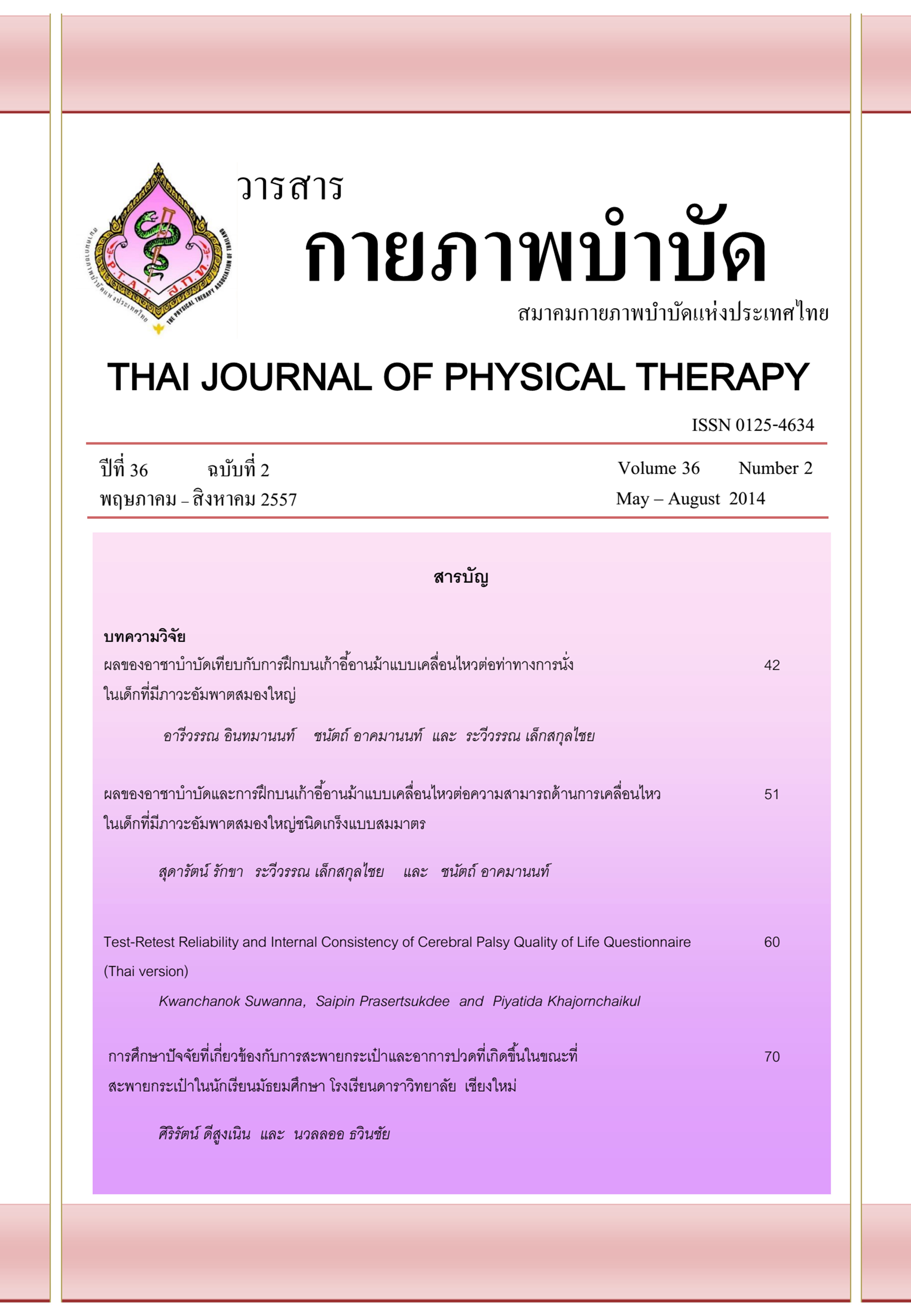ผลของอาชาบำบัดเทียบกับการฝึกบนเก้าอี้อานม้าแบบเคลื่อนไหวต่อท่าทางการนั่ง ในเด็กที่มีภาวะอัมพาตสมองใหญ่
Main Article Content
บทคัดย่อ
เด็กที่มีภาวะอัมพาตสมองใหญ่ (Cerebral Palsy; CP) ส่วนใหญ่มีปัญหาเรื่องการควบคุมการเคลื่อนไหวของกระดูกเชิงกราน (pelvis) ส่งผลให้เด็กนั่งหลังโกง (thoracic kyphosis) ทำให้จำกัดการเคลื่อนไหวของแขนและมือในการทำกิจกรรมต่างๆ อันนำมาสู่การฝึกเพื่อกระตุ้นให้เกิดการเคลื่อนไหวของกระดูกเชิงกรานด้วยอาชาบำบัด (Hippotherapy; HP) และเก้าอี้อานม้าแบบเคลื่อนไหว (Dynamic saddle seat; DS) โดยทั้ง 2 วิธีใช้หลักการเดินของม้าซึ่งช่วยทำให้กระดูกเชิงกรานของผู้ขี่เกิดการเคลื่อนไหวในลักษณะที่คล้ายกับการเดินของคน งานวิจัยครั้งนี้ศึกษาเปรียบเทียบความแตกต่างของค่ามุมงอข้อสะโพก (hip flexion) และมุมการเอียงของกระดูกเชิงกราน (pelvic tilt) ระหว่างเด็กที่มีภาวะอัมพาตสมองใหญ่ 2 กลุ่ม กลุ่มละ 5 คน คือกลุ่มได้รับอาชาบำบัด และกลุ่มได้รับการฝึกบนเก้าอี้อานม้าแบบเคลื่อนไหว เป็นเวลา 6 สัปดาห์ ผลการศึกษาไม่พบความแตกต่างกันของค่ามุม pelvic tilt ระหว่าง 2 กลุ่ม แต่มีความแตกต่างอย่างมีนัยสำคัญทางสถิติของค่ามุม hip flexion หลังจากฝึกในสัปดาห์ที่ 6 (p- value= 0.009) โดยผู้เข้าร่วมงานวิจัยกลุ่ม HP สามารถงอสะโพกได้มากกว่ากลุ่ม DS ส่วนผลการเปรียบเทียบภายในกลุ่มพบความแตกต่างอย่างมีนัยสำคัญทางสถิติในการเปลี่ยนแปลงของค่ามุมงอข้อสะโพกและมุมการเอียงของกระดูกเชิงกราน หลังฝึกครบ 6 สัปดาห์ทั้งสองกลุ่ม ซึ่งสรุปผลการศึกษาได้ว่าการฝึก 6 สัปดาห์ เพียงพอที่จะทำให้เกิดการเปลี่ยนแปลงของมุม hip flexion และ pelvic tilt อันมีผลต่อท่าทางการนั่งในเด็กที่มีภาวะอัมพาตสมองใหญ่
Article Details
เอกสารอ้างอิง
2. Granados AC, Agís IF. Why children with special needs feel better with hippotherapy sessions: a conceptual review. Journal Altern Complement Med. 2011: 17(3); 191- 7.
3. Shurtlef TL, Standeven JW, Engsberg JR. Changes in dynamic trunk/head stability and functional reach after hippotherapy. Arch Phys Med Rehabil. 2009: 90; 1185- 95.
4. Bertoti DB. Effect of therapeutic horseback riding on posture in children with cerebral palsy. Phys Ther. 1988: 68; 1505- 12.
5. Encheff JL, Armstrong C, Masterson M et al. Hippotherapy effects on trunk, pelvic, and hip motion during ambulation in children with neurological impairments. Pediatr Phys Ther. 2012; 24(3): 242- 50.
6. Silkwood-Sherer DJ, Killian CB, Long TM et al. Hippotherapy- an intervention to habilitate balance deficits in children with movement disorders: a clinical trial. Phys Ther. 2012; 92(5): 707- 17.
7. Chung J, Evans J, Lee C et al. Effectiveness of adaptive seating on sitting posture and postural control in children with cerebral palsy. Pediatr Phys Ther. 2008; 20(4):303- 17.
8. Sprigle S, Wootten M, Bresler M, Flinn N. Development of noninvasive measure of pelvic and hip angle in seat posture. Arch Phys Med Rehabil. 2002; 83(11):1597- 602.
9. Sprigle S, Flinn N, Wootten M, McCorry S. Development and testing of a pelvic goniometer designed to measure pelvic tilt and hip flexion. Clin Biomech. 2003; 18(5): 462- 5.
10. McGibbon NH, Andrade CK, Widener G et al. Effect of an equine movement therapy program on gait energy expenditure, and motor function in children with spastic cerebral palsy: a pilot study. Dev Med Child Neurol. 1998; 40: 754- 62.


